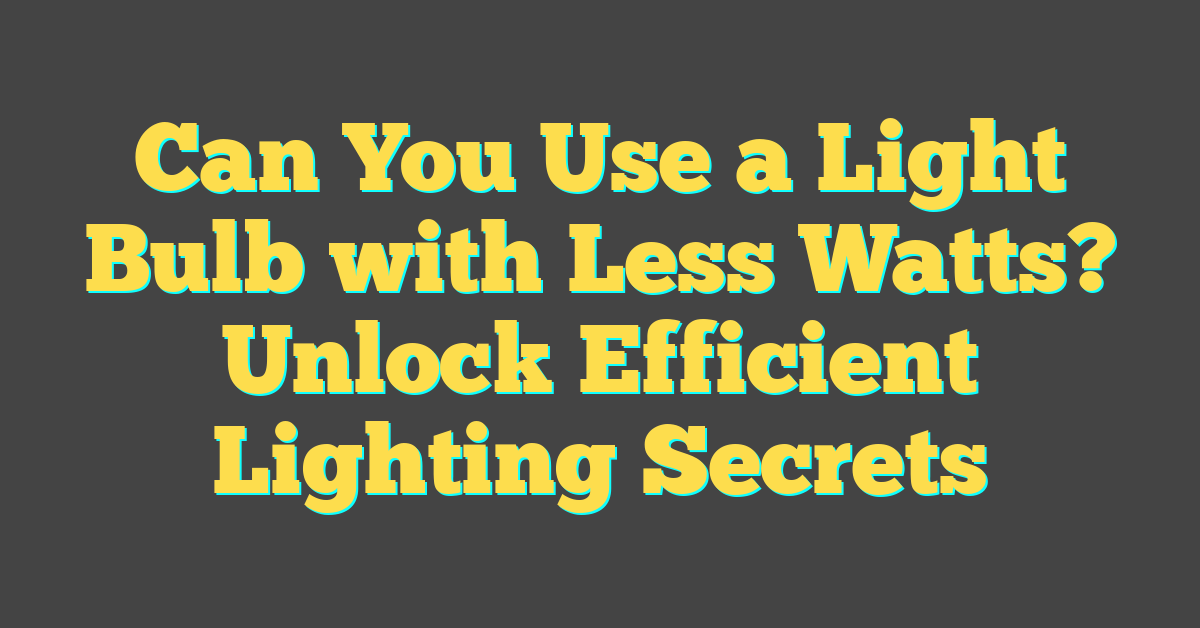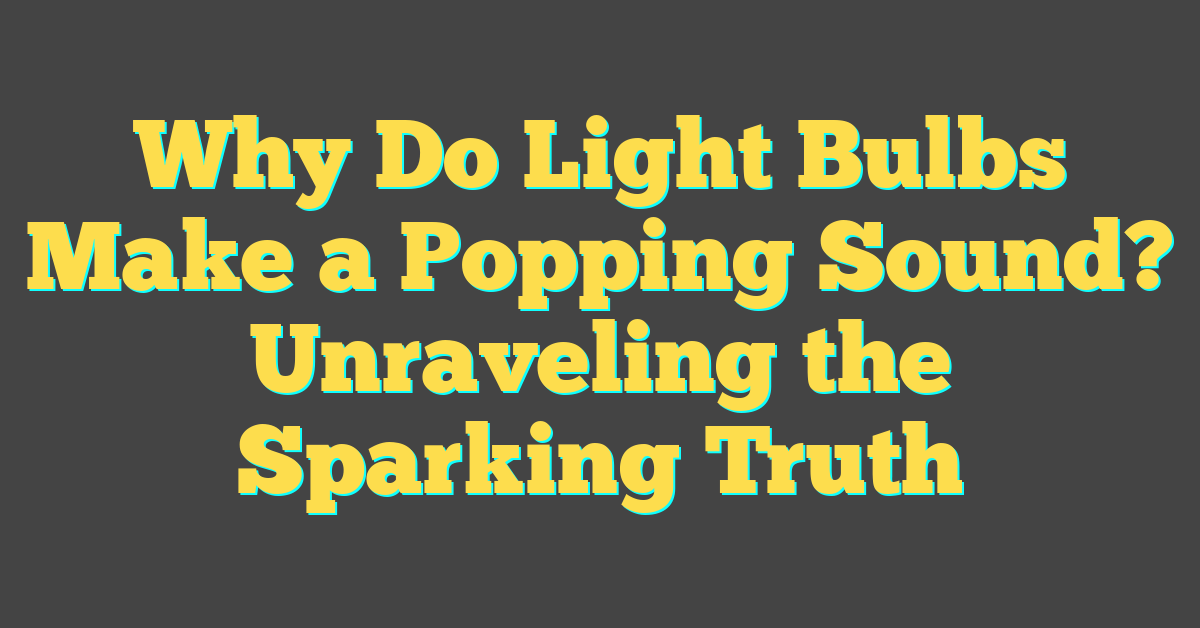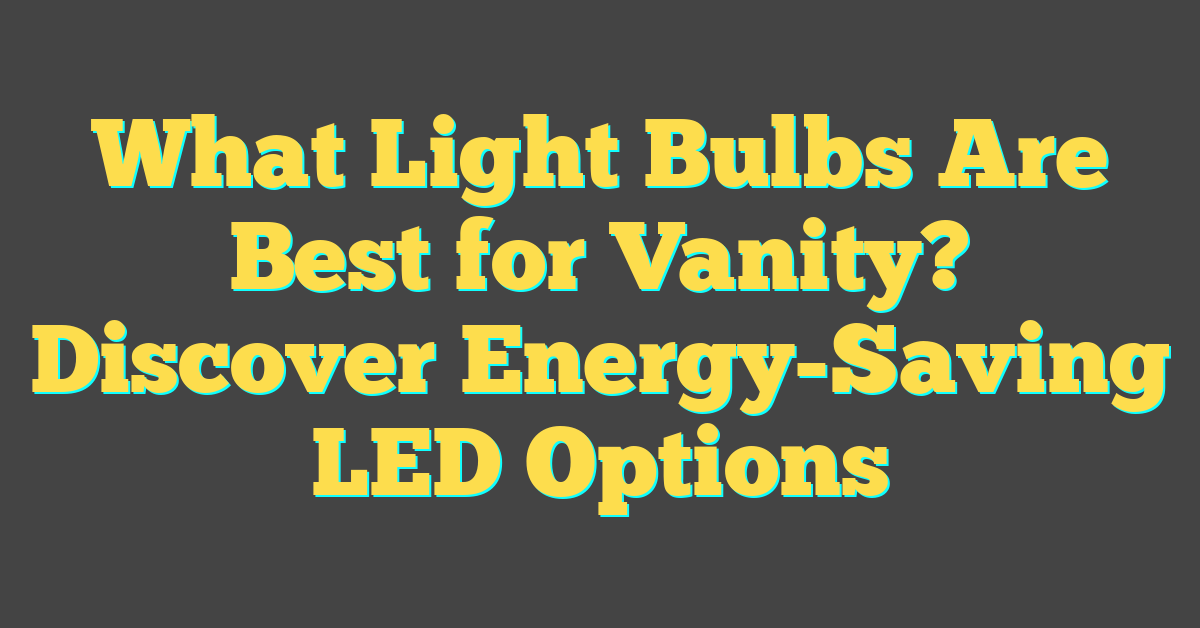Lighting plays a crucial role in setting the ambiance of your home and ensuring you can see your surroundings clearly. With the plethora of light bulb options in the market, from traditional incandescent bulbs to energy-efficient LEDs and smart bulbs, you can select products that fit your specific needs and preferences. Not only do these bulbs differ in terms of brightness and color temperature, but they also offer varying lifespans and energy consumption levels, which can substantially impact your electricity bills and carbon footprint.


Smart lighting technology has transformed the way you interact with the lights in your home. You now have the convenience of adjusting brightness, setting schedules, and even changing colors with a tap on your smartphone or a voice command, thanks to integration with home automation systems. With design and styling also becoming a key consideration, manufacturers are offering bulbs that are not only functional but also aesthetically pleasing, blending seamlessly with the decor of any room.
Key Takeaways
- A wide range of light bulb options allows for personalization of brightness, color, and energy usage.
- Smart bulbs provide convenience and control over home lighting with advanced features.
- Selecting the right bulb involves considering design, functionality, and environmental impact.
History of Light Bulbs
The history of light bulbs is a journey from early incandescent designs to modern LED technologies. You’ll see how innovation and energy efficiency have driven the evolution of lighting.
From Incandescence to Fluorescent
Incandescent bulbs have a simple yet fascinating origin. It was the 19th century when notable inventors like Thomas Edison began commercializing the electric light bulb. Despite many contributors to its invention, Edison’s bulb, which lasted a remarkable 13.5 hours, is often highlighted for bringing practical incandescent lighting to the public. Edison’s successful design relied on a resistant filament that glowed when electricity passed through it, casting a warm, amber light.
Moving forward, fluorescent lighting arrived with a completely different technology. In a fluorescent tube, electricity excites mercury vapor which, in turn, emits ultraviolet light. That light then causes a phosphor coating on the inside of the tube to glow, producing visible light. Fluorescent tubes were more energy efficient than incandescents and lasted longer, which made them popular in commercial and industrial spaces. In your own home or school, you might have seen these tubes casting their distinct bright, white light.
Rise of LEDs and Energy Efficiency
The rise of LEDs (Light Emitting Diodes) marks a significant turn towards energy efficiency in lighting. Unlike incandescents, LEDs do not rely on a filament, and unlike fluorescents, there are no gasses that need to be excited. Instead, LEDs produce light by passing electricity through a semiconductor, which then emits photons – the most energy-efficient method we’ve developed so far.
You’ve undoubtedly noticed the impact of LEDs; their small size and low power consumption have allowed for versatile designs in everything from tiny indicator lights to room-filling ceiling fixtures. Moreover, their long lifespan means you’re not replacing them as often, which is better for both your wallet and the environment. It’s no wonder that LEDs are replacing older technologies at a quick pace, signifying a move toward a more energy-conscious world.
The light bulb’s timeline is a reminder that even everyday objects like the bulbs illuminating your room have rich histories of innovation, directly impacting how you experience the world.
Types of Light Bulbs
When you’re ready to brighten up your space, the type of light bulb you choose matters just as much as your light fixture. With a variety of bulbs from traditional incandescents to energy-efficient LEDs, each type offers different benefits for your home’s ambiance and energy consumption.
Understanding Incandescent Bulbs
Incandescent bulbs are the classic light bulbs that have lit homes for over a century. They work by heating a filament until it glows, providing a warm, inviting light. Incandescent bulbs tend to have a shorter lifespan and are less energy-efficient compared to other types.
The Versatility of LED Bulbs
LED bulbs stand out for their longevity and energy efficiency. Emitting light through the movement of electrons in a semiconductor material, they use significantly less power and can last years longer than traditional bulbs. You’ll find LED options that can mimic the warmth of incandescents or provide bright, clear light for tasks.
Fluorescent & CFLs: A Comparison
Fluorescent bulbs, commonly seen in tube shapes, are filled with mercury vapor that emits UV light when electrified. Compact Fluorescent Lamps (CFLs) are the coiled versions of these tubes and fit in most standard light fixtures. Both offer longer life and improved energy savings over incandescents but may take a moment to warm up to full brightness.
Halogen and Its Characteristics
Halogen light bulbs are a type of incandescent that use halogen gas to increase output and efficiency. They produce a bright, white light and are often used in floodlights and spotlights. While more efficient than traditional incandescents, they run hotter and may not match the energy savings of LEDs or CFLs.
Light Bulb Features

When you’re selecting a light bulb, the brightness, color temperature, energy efficiency, and longevity are crucial features to consider. Let’s explore how these attributes can affect your daily use and overall satisfaction with your light bulb choice.
Brightness Levels and Lumens
Your choice in brightness can transform a room from dimly lit to brilliantly illuminated. Brightness is measured in lumens, not watts, which is a common misconception. The higher the lumens, the brighter the bulb. For instance, to replace a 60-watt traditional bulb, you’d look for an LED bulb with about 800 lumens.
Color Temperature and Mood
« 2 Pack Rechargeable LED Headlamp Review: Worth Every Penny?
Why Switch to LED Light Bulbs: The Bright Choice for Energy Savings »
Color temperature significantly affects the mood of your space. Measured in Kelvin (K), lower values mean a warmer, yellowish light, while higher numbers give a cooler, bluish hue. A cozy setting might use bulbs around 2700K, creating a warm, inviting glow ideal for relaxation.
Energy Efficiency and Electricity
Energy-efficient bulbs, such as LEDs or CFLs, consume fewer watts to give off the same level of brightness, saving you on electricity costs. For instance, an LED might use only 15 watts to provide the same brightness as a 60-watt incandescent, demonstrating a commitment to both your wallet and the environment.
Bulb Longevity
A bulb’s lifespan is equally important. LEDs often have a long lifespan, lasting up to 25,000 hours or more. That’s years of use before you need a replacement, ensuring less waste and frequent purchasing. Opt for bulbs that tout a longer life for both convenience and cost savings over time.
Design and Styling
When considering upgrading the lighting in your home, the design and style of the light bulbs you choose can significantly impact the ambiance and aesthetic of a room. Whether you’re seeking a retro charm or a modern sleekness, the market offers a variety of options to match your interior design preferences.
Vintage-Style and Edison Bulbs
Your love for nostalgic decor can be indulged with vintage-style light bulbs. These are often designed to mimic the look of the original Edison bulbs, featuring a warm glow and filament design that exudes a cozy, antique atmosphere. The Spruce notes the importance of selecting the right bulb for its desired effect at home, and vintage bulbs are perfect for adding a touch of yesteryear elegance to any space.
Designers have embraced these bulbs for their ability to create a focal point in a room without requiring a complete redesign. You can easily integrate them into a variety of fixtures, from exposed pendant lights to simple table lamps, for an instant infusion of old-world charm.
Modern LED and Sleek Designs
In contrast to the classic styles, modern LED bulbs deliver a crisp and clean light, suitable for a contemporary home. Their sleek design and advanced technology are not only appealing but also energy-efficient. For example, Philips offers a range of LED bulbs that provide long-lasting lighting solutions while maintaining a stylish, minimalistic look.
Modern bulbs aren’t just functional; they come in various shapes and sizes to match your modern decor preferences. You’ll find that these LED bulbs often serve as a design element in their own right, capable of complementing a modern, uncluttered aesthetic and providing bright, comfortable lighting for your everyday tasks.
Smart Lighting Technology
With smart lighting technology, you gain unparalleled control over your home’s ambiance and energy efficiency. By integrating smart bulbs into your home automation system, you can customize lighting to suit any occasion or schedule.
Smart Bulbs and Home Automation
Smart bulbs are at the core of modern home automation. Brands like Philips Hue offer color-changing and dimmable options, allowing you to adjust the brightness and color of your lights to match your mood or activity. Pairing these bulbs with a smart home ecosystem, such as HomeKit, enables you to orchestrate every fixture in your house seamlessly.
- Compatibility: Smart light bulbs work with various home automation platforms.
- Energy-Efficient: Many smart bulbs are LED, reducing your energy usage.
- Customization: Adjust colors and brightness to create your ideal setting.
Voice Commands and Interconnectivity
Imagine changing the mood of your room just with your voice. With voice command features through assistants like Google Assistant or Amazon Alexa, your smart bulbs respond to your spoken instructions. This not only enhances ease of use but also ties different smart home devices together for a more interconnected experience.
- Hands-Free Control: Just say what you need, and your smart home listens.
- Multi-Device Ecosystem: Smart bulbs link with other devices for a fluid, automated home environment.
Scheduling and Remote Access
Your smart light bulbs can follow timers and schedules, so your lights can automatically turn on or off at specific times, whether you’re home or not. This is not only convenient but also a great way to make your home appear occupied while you’re away, adding an extra layer of security.
- Set Schedules: Plan lighting according to your daily routine.
- Remote Control: Access your home lighting from anywhere via your smartphone.
Smart lighting technology gives you the flexibility to enjoy the perfect lighting anytime, enhances your property’s security, and can even help reduce energy costs—all with a simple voice command or a tap on your device.
Brand Overview and Innovations

When choosing light bulbs, you want to go with brands that bring both quality and innovation to the table. You’ll find that companies like Philips, Cree, and GE Lighting have pushed the boundaries of what light bulbs can do. Let’s dive into how these brands stand out in the market and what each one offers to brighten your world.
Philips Hue and Its Ecosystem
Philips is a forerunner in the smart lighting space, particularly with their Philips Hue bulbs. These innovative bulbs integrate with a vast ecosystem, allowing you to control lighting from your smartphone or voice commands through compatibility with Amazon Alexa and other smart home systems. Philips Hue’s ecosystem extends beyond just illumination, offering features like color changing, scheduling, and syncing with music or movies for an immersive experience.
Cree Bulbs and Durability
Cree bulbs are lauded for their durability and long lifespan. The brand is known for creating high-quality LED bulbs that not only save you energy but also reduce the need for frequent replacements. They have made waves in the lighting industry by offering affordable LED solutions that promise longevity, making Cree bulbs a smart choice for cost-effective and sustainable home lighting.
GE Lighting and Feit Electric
GE Lighting has been a trusted name in the industry, known for reliable light bulbs that cover a range of needs, from standard incandescent bulbs to advanced LED options. Pairing up with Feit Electric, they offer a variety of lighting solutions including dimmable and smart bulbs. These brands focus on providing you with innovative features such as energy-efficient designs that help to lower your electricity bills while still delivering high-performance lighting for your home or office.
Choosing the Right Bulb
When selecting the best light bulb for your space, consider the room’s function, desired mood, and specific lighting needs. The right bulb can enhance the ambiance, provide functional lighting, and cater to the unique requirements of each area in your home.
By Room: Kitchens, Bathrooms, Bedrooms
Kitchens: Brightness is key in your kitchen where you prepare meals. Opt for LED bulbs with a higher lumen count – look for bulbs with at least 800 lumens to ensure you have enough light. Color temperature also plays a role; a cooler color temperature around 4000K can make the space feel clean and efficient.
Bathrooms: For the bathroom, a combination of light quality and color is essential. A bulb with about 2700 to 3000 K will give you a warm light that is flattering and welcoming, ideal for getting ready in the morning or relaxing in the tub.
Bedrooms: Your bedroom lighting should create a serene and restful environment. Warm light bulbs with lower lumens promote relaxation before sleeping. You might choose bulbs around 2700 K similar to incandescent bulbs for a cozy, calm setting.
For Mood: Brightness, Color, and Dimming
Brightness: Adjusting brightness is crucial for dialing in your preferred ambiance. Brightness is measured in lumens; the higher the lumens, the brighter the light.
Color Ambiance: Color temperature affects the perceived warmth or coolness of the light. Warmer colors (lower K) create a relaxing atmosphere, while cooler colors (higher K) are energizing and better for task lighting.
Dimming: Dimmable bulbs, like these options, give you control over the light output and can significantly impact the mood of a room. Make sure your switch is compatible with your dimmable bulbs to avoid flickering or reduced bulb life.
Bulb Types for Specific Purposes
For tailored lighting needs, you’ll want to match bulb types to their intended use:
LED: Best for energy efficiency and a longer lifespan. They fit almost any lighting need and come in various shapes and brightness levels.
Incandescent: Traditional bulbs that provide warm light but are less energy-efficient. Suitable for a soft glow in living spaces.
Specialty Bulbs: Look for bulbs with specific base sizes and shapes for unique fixtures, such as chandeliers or outdoor lights. Be aware that sizes and bases vary — a guide like this one can help you understand the different types.
Remember, always check the maximum wattage allowed for your fixture to ensure safe and effective lighting.
Lighting Your Home
Choosing the right lighting for your home can dramatically enhance the ambiance and safety of your living spaces. Whether you’re illuminating your living room or brightening up your backyard, understanding the differences in lighting options is key.
Indoor vs. Outdoor Lighting
Indoor lighting sets the mood of your rooms and provides task lighting for activities like reading or cooking. With products like the GE Reveal LED, you can enjoy a clean, natural light indoors. On the other hand, outdoor lighting should be durable and weather-resistant. Opt for bulbs specifically designed for exterior use to ensure longevity and performance under tough conditions.
Creating Cozy Spaces with Light
To create a cozy atmosphere, choose warm-toned bulbs for areas like living rooms and bedrooms. This mimics the inviting glow of firelight. Bulbs labeled as “soft white” or “warm white,” such as those reviewed by The Spruce, are perfect for these spaces. They help relax the mind and make your home feel welcoming.
Safety and UL Listed Products
For safety, always use UL Listed light bulbs, as their safety certification means they’ve met rigorous testing standards. This is particularly critical for outdoor light fixtures to prevent electrical hazards. The SANSI LED Light Bulbs pack, for example, could be a safe and reliable option for various applications in your home. Remember, when handling or changing bulbs, ensure the electricity is turned off to avoid shocks.
Installation and Maintenance

When it comes to selecting light bulbs for your home, longevity and ease of installation are critical. This section provides you with resources to install and maintain lighting by yourself, or with the help of professional services like Angi and Mister Sparky.
Do-It-Yourself Guides
If you’re looking to handle light bulb installation on your own, it’s important for you to know that many new bulbs are designed for easy installation. Before starting, always ensure your light switch is turned off. For detailed step-by-step instructions, reading guides like “How to Upgrade and Replace Lightbulbs” by The Family Handyman can be immensely helpful. Here’s a quick checklist:
- Choose a bulb: Opt for long-lasting LED bulbs for efficiency.
- Safety first: Turn off the power at the circuit breaker.
- Remove old bulb: Twist counterclockwise until loose.
- Install new bulb: Insert bulb into socket and twist clockwise.
Remember, proper maintenance, such as regular cleaning, can also extend the life of your bulbs.
Professional Services: Angi and Mister Sparky
Sometimes, you might prefer or require professional assistance, especially for complex installations or electrical work. Companies like Angi provide a platform to find and book trustworthy local professionals for nearly any home project. For specialized electrical services, Mister Sparky offers expert lighting solutions, where you can schedule services for maintenance or installation. They ensure safety and longevity of your lighting systems, and you can rest assured knowing that your home’s lighting is in good hands.
Eco-Friendly and Regulatory Compliance
In pursuing eco-friendly lighting options, you should consider not only the energy efficiency of your bulbs but also their compliance with regulatory standards. These aspects together ensure you’re selecting products that are both environmentally responsible and in line with current regulations.

Energy Star-Certified Bulbs
Energy Star-certified bulbs are a hallmark of energy efficiency. To earn this label, bulbs undergo rigorous testing to meet strict efficiency standards set by the EPA. By choosing Energy Star-certified bulbs, you’re opting for products that use about 70-90% less energy than traditional models. For example, Compact Fluorescent Lamps (CFLs), labeled by Energy Star, use roughly 25% of the energy an incandescent bulb uses and can last up to 10 times longer.
Impact on Environment and Recycling
Energy-efficient bulbs, like CFLs and LEDs, not only lower electric bills but also reduce your carbon footprint. Less energy usage means fewer greenhouse gas emissions from power plants. Furthermore, when it’s time to dispose of them, CFLs need special handling due to their mercury content—so remember to recycle responsibly. Programs are available for recycling these products, supporting your efforts in reducing waste in landfills and promoting a healthier environment.




